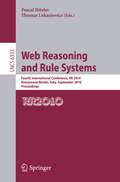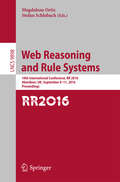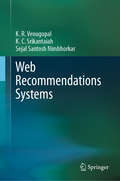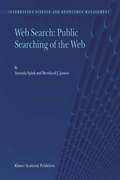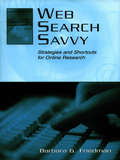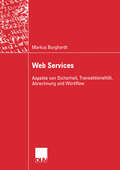- Table View
- List View
Web Reasoning and Rule Systems: Fourth International Conference, RR 2010, Bressanone/Brixen, Italy, September 22-24, 2010. Proceedings (Lecture Notes in Computer Science #6333)
by Pascal Hitzler Thomas LukasiewiczWeb Reasoning and Rule Systems: 8th International Conference, RR 2014, Athens, Greece, September 15-17, 2014. Proceedings (Lecture Notes in Computer Science #8741)
by Roman Kontchakov Marie-Laure MugnierThis book constitutes the refereed proceedings of the 8th International Conference on Web Reasoning and Rule Systems, RR 2014, held in Athens, Greece in September 2014. The 9 full papers, 9 technical communications and 5 poster presentations presented together with 3 invited talks, 3 doctoral consortial papers were carefully reviewed and selected from 33 submissions. The conference covers a wide range of the following: semantic Web, rule and ontology languages, and related logics, reasoning, querying, searching and optimization, incompleteness, inconsistency and uncertainty, non-monotonic, common sense, and closed-world reasoning for the web, dynamic information, stream reasoning and complex event processing, decision making, planning, and intelligent agents, machine learning, knowledge extraction and information retrieval, data management, data integration and reasoning on the web of data, ontology-based data access, system descriptions, applications and experiences.
Web Reasoning and Rule Systems: 6th International Conference, RR 2012, Vienna, Austria, September 10-12, 2012, Proceedings (Lecture Notes in Computer Science #7497)
by Markus Kroetzsch Umberto StracciaThis book constitutes the refereed proceedings of the 6th International Conference on Web Reasoning and Rule Systems, RR 2012, held in Vienna, Austria, in September 2012. The 27 revised research papers, presented together with 2 invited talks and 5 research summaries were carefully reviewed and selected from 42 submissions. The papers were organized in topical sections on technical communications, algorithms, design aspects of rule markup, design of ontology languages, engineering of engines, translators, and other tools, standardization efforts, such as the Rules Interchange Format activity at W3C, and applications.
Web Reasoning and Rule Systems: First International Conference, RR 2007, Innsbruck, Austria, June 7-8, 2007, Proceedings (Lecture Notes in Computer Science #4524)
by Massimo Marchiori Jeff Z. Pan Christian De Sainte MarieThis book constitutes the refereed proceedings of the First International Conference on Web Reasoning and Rule Systems, RR 2007, held in Innsbruck, Austria. It address all current topics in Web reasoning and rule systems, including acquisition of rules and ontologies by knowledge extraction, design and analysis of reasoning languages, reasoning with constraints, rule languages and systems, semantic Web services modeling and applications.
Web Reasoning and Rule Systems: 10th International Conference, RR 2016, Aberdeen, UK, September 9-11, 2016, Proceedings (Lecture Notes in Computer Science #9898)
by Magdalena Ortiz Stefan SchlobachThis book constitutes the refereed proceedings of the 10th International Conference on Web Reasoning and Rule Systems, RR 2016, held in Aberdeen, Scotland, UK, in September 2016.The 10 full papers and 3 technical communications presented were carefully reviewed and selected from 17 submissions. Extensions and adaptations of classical rule-based languages have found their application in a range of areas, such as ontologies for the semantic web; querying web data; semantic data management; common-sense reasoning on the web
Web Reasoning and Rule Systems: Third International Conference, RR 2009, Chantilly, VA, USA, October 25-26, 2009, Proceedings (Lecture Notes in Computer Science #5837)
by Axel Polleres Terrance SwiftThepromiseoftheSemanticWeb,atits most expansive, is to allow knowledge to be freely accessed and exchanged by software. It is now recognized that if the SemanticWebis to containdeepknowledge,theneedfornewrepresentationand reasoning techniques is going to be critical. These techniques need to ?nd the righttrade-o?betweenexpressiveness,scalabilityandrobustnesstodealwiththe inherently incomplete, contradictory and uncertain nature of knowledge on the Web. The International Conference on Web Reasoning and Rule Systems (RR) was founded to address these needs and has grown into a major international forum in this area. The third RR conference was held during October 25–26, 2009 in Chantilly, Virginia, co-located with the International Semantic Web Conference (ISWC 2009). This year 41 papers were submitted from authors in 21 countries. The P- gram Committee performed outstandingly to ensure that each paper submitted to RR 2009 was thoroughly reviewed by at least three referees in a short - riod of time. The resulting conference presented papers of high quality on many of the key issues for reasoning on the Semantic Web. RR 2009 was fortunate to have two distinguished invited speakers. Robert Kowalski, in his talk “- tegrating Logic Programming and Production Systems with Abductive Logic Programming Agents” addressed some of the fundamental considerations - hind reasoning about evolving systems. Benjamin Grossof’s talk “SILK: Higher Level Rules with Defaults and Semantic Scalability” described the design of a major next-generation rule system. The invited tutorial “Uncertainty Reas- ing for the Semantic Web” by Thomas Lukasiewicz provided perspectives on a central issue in this area.
Web Reasoning and Rule Systems: 5th International Conference, RR 2011, Galway, Ireland, August 29-30, 2011, Proceedings (Lecture Notes in Computer Science #6902)
by Sebastian Rudolph Claudio GutierrezThis book constitutes the refereed proceedings of the 5th International Conference on Web Reasoning and Rule Systems, RR 2011, held in Galway, Ireland in August 2011. The 13 revised full papers, 12 revised short papers presented together with 2 invited talks were carefully reviewed and selected from 36 submissions. The papers address all current topics in Semantic Web, interplay between classical reasoning approach with welll established web languages such as RDF and OWL, reasoning languages, querying and optimization and rules and ontologies.
Web Recommendations Systems
by K. R. Venugopal K. C. Srikantaiah Sejal Santosh NimbhorkarThis book focuses on Web recommender systems, offering an overview of approaches to develop these state-of-the-art systems. It also presents algorithmic approaches in the field of Web recommendations by extracting knowledge from Web logs, Web page content and hyperlinks. Recommender systems have been used in diverse applications, including query log mining, social networking, news recommendations and computational advertising, and with the explosive growth of Web content, Web recommendations have become a critical aspect of all search engines. The book discusses how to measure the effectiveness of recommender systems, illustrating the methods with practical case studies. It strikes a balance between fundamental concepts and state-of-the-art technologies, providing readers with valuable insights into Web recommender systems.
The Web Resource Space Model (Web Information Systems Engineering and Internet Technologies Book Series #4)
by Hai ZhugeThe author, an internationally cited expert in the knowledge grid field, introduces the Resource Space Model (RSM) to help you effectively organize and manage resources by normalizing classification semantics. After setting forth basic models of RSM and the Semantic Link Network, the author establishes the relationship between the two models and sets forth an approach to integrating the two and exploring their semantic rich interconnections.
Web-Scale Data Management for the Cloud
by Wolfgang Lehner Kai-Uwe SattlerThe efficient management of a consistent and integrated database is a central task in modern IT and highly relevant for science and industry. Hardly any critical enterprise solution comes without any functionality for managing data in its different forms. Web-Scale Data Management for the Cloud addresses fundamental challenges posed by the need and desire to provide database functionality in the context of the Database as a Service (DBaaS) paradigm for database outsourcing. This book also discusses the motivation of the new paradigm of cloud computing, and its impact to data outsourcing and service-oriented computing in data-intensive applications. Techniques with respect to the support in the current cloud environments, major challenges, and future trends are covered in the last section of this book. A survey addressing the techniques and special requirements for building database services are provided in this book as well.
Web Scraping with Python
by Richard LawsonSuccessfully scrape data from any website with the power of Python About This Book • A hands-on guide to web scraping with real-life problems and solutions • Techniques to download and extract data from complex websites • Create a number of different web scrapers to extract information Who This Book Is For This book is aimed at developers who want to use web scraping for legitimate purposes. Prior programming experience with Python would be useful but not essential. Anyone with general knowledge of programming languages should be able to pick up the book and understand the principals involved. What You Will Learn • Extract data from web pages with simple Python programming • Build a threaded crawler to process web pages in parallel • Follow links to crawl a website • Download cache to reduce bandwidth • Use multiple threads and processes to scrape faster • Learn how to parse JavaScript-dependent websites • Interact with forms and sessions • Solve CAPTCHAs on protected web pages • Discover how to track the state of a crawl In Detail The Internet contains the most useful set of data ever assembled, largely publicly accessible for free. However, this data is not easily reusable. It is embedded within the structure and style of websites and needs to be carefully extracted to be useful. Web scraping is becoming increasingly useful as a means to easily gather and make sense of the plethora of information available online. Using a simple language like Python, you can crawl the information out of complex websites using simple programming. This book is the ultimate guide to using Python to scrape data from websites. In the early chapters it covers how to extract data from static web pages and how to use caching to manage the load on servers. After the basics we'll get our hands dirty with building a more sophisticated crawler with threads and more advanced topics. Learn step-by-step how to use Ajax URLs, employ the Firebug extension for monitoring, and indirectly scrape data. Discover more scraping nitty-gritties such as using the browser renderer, managing cookies, how to submit forms to extract data from complex websites protected by CAPTCHA, and so on. The book wraps up with how to create high-level scrapers with Scrapy libraries and implement what has been learned to real websites. Style and approach This book is a hands-on guide with real-life examples and solutions starting simple and then progressively becoming more complex. Each chapter in this book introduces a problem and then provides one or more possible solutions.
Web Search: Multidisciplinary Perspectives (Information Science and Knowledge Management #14)
by Amanda Spink Michael ZimmerWeb search engines are not just indispensable tools for finding and accessing information online, but have become a defining component of the human condition and can be conceptualized as a complex behavior embedded within an individual's everyday social, cultural, political, and information-seeking activities. This book investigates Web search from the non-technical perspective, bringing together chapters that represent a range of multidisciplinary theories, models, and ideas.
Web Search: Public Searching of the Web (Information Science and Knowledge Management #6)
by Amanda Spink Bernard J. JansenThis book brings together results from the Web search studies we conducted from 1997 through 2004. The aim of our studies has been twofold: to examine how the public at large searches the Web and to highlight trends in public Web searching. The eight-year period from 1997 to 2004 saw the beginnings and maturity of public Web searching. Commercial Web search engines have come and gone, or endured, through the fall of the dot.com companies. We saw the rise and, in some cases, the demise of several high profile, publicly available Web search engines. The study of the Web search is an exciting and important area of interdisciplinary research. Our book provides a valuable insight into the growth and development of human interaction with Web search engines. In this book, our focus is on the human aspect of the interaction between user and Web search engine. We do not investigate the Web search engines themselves or their constantly changing interfaces, algorithms and features. We focus on exploring the cognitive and user aspects of public Web searching in the aggregate. We use a variety of quantitative and qualitative methods within the overall methodology known as transaction log analysis.
Web Search Savvy: Strategies and Shortcuts for Online Research
by Barbara G. FriedmanWeb Search Savvy: Strategies and Shortcuts for Online Research provides readers of all skill levels with efficient search strategies for locating, retrieving, and evaluating information on the Internet. Utilizing her experience as a reporter working on deadline, author Barbara G. Friedman offers the most effective methods for finding useful and trustworthy data online, and presents these techniques in a straightforward, user-friendly manner.Anyone who uses the Internet for research will find much of value here, including techniques that harness the power of advanced searches to optimize search results, avoid advertising clutter, and locate low- or no-cost databases. Screen captures and diagrams illustrate the steps, rationale, and results to accompany various search strategies. This book emphasizes techniques that make the Web work for individuals rather than for advertisers, such as choosing the most appropriate search engine for the job and tweaking its advanced options to narrow a search and optimize results; identifying cost-free sources of online data; using creative approaches to locate information; evaluating the integrity of online data; and protecting the privacy of the researchers and the researched.Web Search Savvy is an essential resource for students, scholars, and practitioners in journalism and mass communications, and it offers practical and useful guidance for anyone researching information online.
Web Searching and Mining (Cognitive Intelligence And Robotics)
by Debajyoti MukhopadhyayThis book presents the basics of search engines and their components. It introduces, for the first time, the concept of Cellular Automata in Web technology and discusses the prerequisites of Cellular Automata. In today’s world, searching data from the World Wide Web is a common phenomenon for virtually everyone. It is also a fact that searching the tremendous amount of data from the Internet is a mammoth task – and handling the data after retrieval is even more challenging. In this context, it is important to understand the need for space efficiency in data storage. Though Cellular Automata has been utilized earlier in many fields, in this book the authors experiment with employing its strong mathematical model to address some critical issues in the field of Web Mining.
Web Security: A WhiteHat Perspective
by Hanqing Wu Liz ZhaoIn late 2013, approximately 40 million customer debit and credit cards were leaked in a data breach at Target. This catastrophic event, deemed one of the biggest data breaches ever, clearly showed that many companies need to significantly improve their information security strategies. Web Security: A White Hat Perspective presents a comprehensive g
Web Security: A WhiteHat Perspective
by Hanqing Wu Liz ZhaoIn late 2013, approximately 40 million customer debit and credit cards were leaked in a data breach at Target. This catastrophic event, deemed one of the biggest data breaches ever, clearly showed that many companies need to significantly improve their information security strategies. Web Security: A White Hat Perspective presents a comprehensive g
Web Service Composition
by Charles J. PetrieThis book carefully defines the technologies involved in web service composition and provides a formal basis for all of the composition approaches and shows the trade-offs among them. By considering web services as a deep formal topic, some surprising results emerge, such as the possibility of eliminating workflows. It examines the immense potential of web services composition for revolutionizing business IT as evidenced by the marketing of Service Oriented Architectures (SOAs).The author begins with informal considerations and builds to the formalisms slowly, with easily-understood motivating examples. Chapters examine the importance of semantics for web services and ways to apply semantic technologies. Topics included range from model checking and Golog to WSDL and AI planning. This book is based upon lectures given to economics students and is suitable for business technologist with some computer science background. The reader can delve as deeply into the technologies as desired.
Web Service Implementation and Composition Techniques
by Hye-Young Paik Angel Lagares Lemos Moshe Chai Barukh Boualem Benatallah Aarthi NatarajanThis book embarks on a mission to dissect, unravel and demystify the concepts of Web services, including their implementation and composition techniques. It provides a comprehensive perspective on the fundamentals of implementation standards and strategies for Web services (in the first half of the book), while also presenting composition techniques for leveraging existing services to create larger ones (in the second half). Pursuing a unique approach, it begins with a sound overview of concepts, followed by a targeted technical discussion that is in turn linked to practical exercises for hands-on learning. For each chapter, practical exercises are available on Github.Mainly intended as a comprehensive textbook on the implementation and composition of Web services, it also offers a useful reference guide for academics and practitioners. Lecturers will find this book useful for a variety of courses, from undergraduate courses on the foundational technology of Web services through graduate courses on complex Web service composition. Students and researchers entering the field will benefit from the combination of a broad technical overview with practical self-guided exercises. Lastly, professionals will gain a well-informed grasp of how to synthesize the concepts of conventional and “newer” breeds of Web services, which they can use to revise foundational concepts or for practical implementation tasks.
Web Service Mining: Application to Discoveries of Biological Pathways
by George Zheng Athman BouguettayaThe new computing environment enabled by advances in service oriented arc- tectures, mashups, and cloud computing will consist of service spaces comprising data, applications, infrastructure resources distributed over the Web. This envir- ment embraces a holistic paradigm in which users, services, and resources establish on-demand interactions, possibly in real-time, to realise useful experiences. Such interactions obtain relevant services that are targeted to the time and place of the user requesting the service and to the device used to access it. The bene?t of such environment originates from the added value generated by the possible interactions in a large scale rather than by the capabilities of its individual components se- rately. This offers tremendous automation opportunities in a variety of application domains including execution of forecasting, of?ce tasks, travel support, intelligent information gathering and analysis, environment monitoring, healthcare, e-business, community based systems, e-science and e-government. A key feature of this environment is the ability to dynamically compose services to realise user tasks. While recent advances in service discovery, composition and Semantic Web technologies contribute necessary ?rst steps to facilitate this task, the bene?ts of composition are still limited to take advantages of large-scale ubiq- tous environments. The main stream composition techniques and technologies rely on human understanding and manual programming to compose and aggregate s- vices. Recent advances improve composition by leveraging search technologies and ?ow-based composition languages as in mashups and process-centric service c- position.
Web Service Patterns: Java Edition
by Paul B. MondayThe author provides a short catalog of design patterns that are typically needed and explains why they are the right ones to use with Web services. Java is used in all examples.
Web Services: Concepts, Architectures and Applications (Data-Centric Systems and Applications)
by Gustavo Alonso Fabio Casati Harumi Kuno Vijay MachirajuLike many other incipient technologies, Web services are still surrounded by a substantial level of noise. This noise results from the always dangerous combination of wishful thinking on the part of research and industry and of a lack of clear understanding of how Web services came to be. On the one hand, multiple contradictory interpretations are created by the many attempts to realign existing technology and strategies with Web services. On the other hand, the emphasis on what could be done with Web services in the future often makes us lose track of what can be really done with Web services today and in the short term. These factors make it extremely difficult to get a coherent picture of what Web services are, what they contribute, and where they will be applied.Alonso and his co-authors deliberately take a step back. Based on their academic and industrial experience with middleware and enterprise application integration systems, they describe the fundamental concepts behind the notion of Web services and present them as the natural evolution of conventional middleware, necessary to meet the challenges of the Web and of B2B application integration. Rather than providing a reference guide or a "how to write your first Web service" kind of book, they discuss the main objectives of Web services, the challenges that must be faced to achieve them, and the opportunities that this novel technology provides. Established, as well as recently proposed, standards and techniques (e.g., WSDL, UDDI, SOAP, WS-Coordination, WS-Transactions, and BPEL), are then examined in the context of this discussion in order to emphasize their scope, benefits, and shortcomings. Thus, the book is ideally suited both for professionals considering the development of application integration solutions and for research and students interesting in understanding and contributing to the evolution of enterprise application technologies.
Web Services: Aspekte von Sicherheit, Transaktionalität, Abrechnung und Workflow (Wirtschaftsinformatik)
by Markus BurghardtMarkus Burghardt stellt die konzeptionellen und technischen Grundlagen von Web Services vor und erarbeitet Konzepte zur Lösung der durch die Themen Sicherheit, Transaktionalität, Abrechnung und Abbildung von Workflow entstehenden Herausforderungen. In zwei Fallstudien wird der Einsatz von Web Services in virtuellen Netzwerken bzw. bei der Kapselung einer plattformabhängigen Softwarekomponente erläutert.
Web Services: Theory and Practice
by Anura GurugeThis is a soup-to-nuts reference guide on all aspects of Web Services - where Web Services is a fast emerging set of Internet-specific middleware technology to further promote the growth of all aspects of e-business via standardization, collaboration and "franchising." This book is best characterized as an executive brief for IT and senior management rather than a nuts-and-bolts technical guide for portal implementers. Think of it as the "Cliffs Notes on Web Services." Given this audience, the book consistently focuses on business needs, value propositions, ROI, proven solutions and actual examples of current implementations. Each chapter also ends with a 10-item "Q&A" section that consolidates and summarizes the information discussed in the chapter. The book is illustrated with detailed technical diagrams, includes lots of arresting subtitles and contains many bullet lists and tables to facilitate (and encourage) productive skimming. Decision makers - the intended readership for this book - gain increasing comfort and confidence as they get into the book that they are getting to see all facets of the issues, on a consistent basis, and that they will not be blind-sided at meetings by people asking 'difficult' questions. At the end of each chapter, Guruge summarizes and reinforces key points, allowing the reader to skim through the topics for crucial information. The book also leverages living outside resources and ensures that the readership always has ready and consistent access to any and all terms, definitions and concepts they might not be familiar with."Debate style" presentation, focusing repeatedly on pros-and-cons, e.g., .NET vs. Java, open vs. proprietary and buy vs. buildAuthor's trademark detailed architectural and network diagrams of portal implementationsQ&A section at end of each chapter
Web Services: European Conference, ECOWS 2004, Erfurt, Germany, September 27-30, 2004, Proceedings (Lecture Notes in Computer Science #3250)
by Liang-Jie ZhangWelcometotheproceedingsofthe2004EuropeanConferenceonWebServices(ECOWS 2004).ECOWSisoneoftheleadinginternationalconferencesfocusingonWebservices. ECOWS2004wasaforumforresearchersandpractitionersfromacademiaandindustry to exchange information regarding advances in the state of the art and practice of Web services, identify emerging research topics, and de?ne the future directions of Web services computing. ECOWS 2004 had a special interest in papers that contribute to the convergence of Web services, Grid computing, e-business and autonomic computing, and papers that apply techniques from one area to another. This conference was called the International Conference on Web Services Europe in 2003. ECOWS 2004 was a sister event of the International Conference onWeb Services 2004 (ICWS 2004), which attracted more than 250 registered participants in San Diego, USA. Web services are characterized by network-based application components and a service-oriented architecture using standard interface description languages and u- form communicationprotocols. Industrial applicationdomainsforWebservicesinclude business-to-business integration, business process integration and management, c- tent management, e-sourcing, composite Web services creation, design collaboration for computer engineering, multimedia communication, digital TV, and interactive Web solutions. Recently, Grid computing has also started to leverage Web services to de?ne standard interfaces for business Grid services and generic reusable Grid resources. The program of ECOWS 2004 featured a variety of papers on topics ranging from Web services and dynamic business process composition to Web services and process management,Web services discovery,Web services security,Web services-based app- cations for e-commerce, Web services-based Grid computing, and Web services solu- ons.
